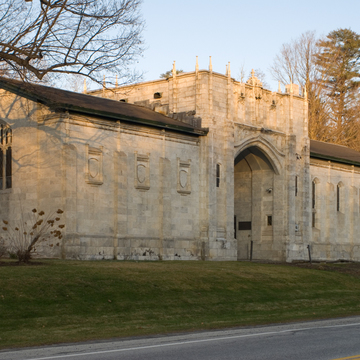Exemplary of the landscaped rural cemetery movement initiated by Mount Auburn Cemetery in Cambridge, Massachusetts, Green Mount Cemetery preserves one of Vermont's finest picturesque landscape ensembles. At the western edge of Montpelier, it occupies four hundred acres of south-facing hillside above the Winooski River purchased with a bequest in 1853. In 1855 the community commissioned Daniel Brims, superintendent of Forest Hills Cemetery in Roxbury, Massachusetts, to lay out the grounds. Patrick Farrelly executed its groves, terraces, winding paths, and stairs cut from living rock. In 1893, the cemetery was celebrated in the Vermont Watchman as “the great glory of Montpelier . . . both for what it contains, its beauty of situation and the perfection of its maintenance.” The plots are marked by a memorable collection of late-nineteenth- and early-twentieth-century memorial sculpture, much of it highly naturalistic and carved by Italian granite workers in Barre. Among the most notable are the Kellogg Memorial with its seated woman and kneeling child atop a ten-foot plinth, and the Hubbard Family Memorial (after 1865) with a wingspread angel against a rock-faced granite cross. The John E. Hubbard Memorial (1901) sets the first funerary commission of sculptor Karl Bitter against a granite enclosure by Austrian architect Hans Kestranek. Bitter's Symbolist bronze depicting a partially shrouded youth, later exhibited under the title Thanatos, has been compared to Augustus Saint-Gaudens's Adams Memorial (1891) in Washington, D.C. A Kellogg bequest in 1890 to replace the cemetery's original iron gate with a chapel/gatehouse resulted in the Gothic Revival marble gateway designed by Boston's Cleveland and Godfrey and dedicated in 1905. It opens through a buttressed Tudor-arched pavilion between a chapel with traceried windows and a receiving vault to a rising green and white vista of marble- and granite-dotted terraces.
You are here
Green Mount Cemetery
1855, Daniel Brims and Patrick Farrelly; 1905, Cleveland and Godfrey. 251 State St., City of Montpelier
If SAH Archipedia has been useful to you, please consider supporting it.
SAH Archipedia tells the story of the United States through its buildings, landscapes, and cities. This freely available resource empowers the public with authoritative knowledge that deepens their understanding and appreciation of the built environment. But the Society of Architectural Historians, which created SAH Archipedia with University of Virginia Press, needs your support to maintain the high-caliber research, writing, photography, cartography, editing, design, and programming that make SAH Archipedia a trusted online resource available to all who value the history of place, heritage tourism, and learning.















